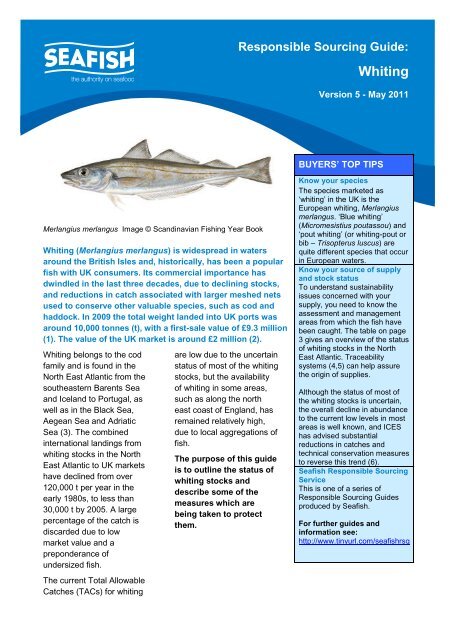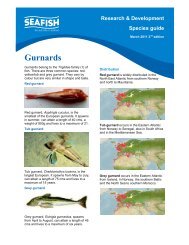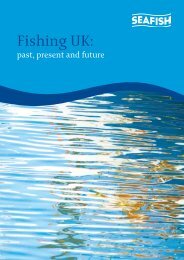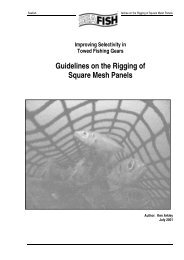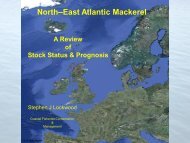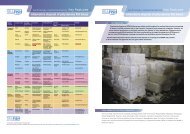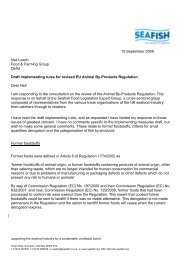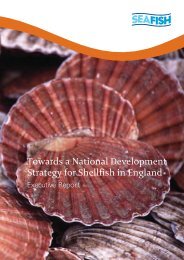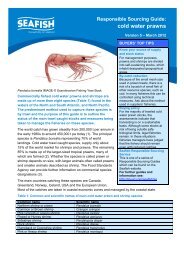Whiting - Seafish
Whiting - Seafish
Whiting - Seafish
You also want an ePaper? Increase the reach of your titles
YUMPU automatically turns print PDFs into web optimized ePapers that Google loves.
Responsible Sourcing Guide:<br />
<strong>Whiting</strong><br />
Version 5 - May 2011<br />
BUYERS’ TOP TIPS<br />
Merlangius merlangus Image © Scandinavian Fishing Year Book<br />
<strong>Whiting</strong> (Merlangius merlangus) is widespread in waters<br />
around the British Isles and, historically, has been a popular<br />
fish with UK consumers. Its commercial importance has<br />
dwindled in the last three decades, due to declining stocks,<br />
and reductions in catch associated with larger meshed nets<br />
used to conserve other valuable species, such as cod and<br />
haddock. In 2009 the total weight landed into UK ports was<br />
around 10,000 tonnes (t), with a first-sale value of £9.3 million<br />
(1). The value of the UK market is around £2 million (2).<br />
<strong>Whiting</strong> belongs to the cod<br />
family and is found in the<br />
North East Atlantic from the<br />
southeastern Barents Sea<br />
and Iceland to Portugal, as<br />
well as in the Black Sea,<br />
Aegean Sea and Adriatic<br />
Sea (3). The combined<br />
international landings from<br />
whiting stocks in the North<br />
East Atlantic to UK markets<br />
have declined from over<br />
120,000 t per year in the<br />
early 1980s, to less than<br />
30,000 t by 2005. A large<br />
percentage of the catch is<br />
discarded due to low<br />
market value and a<br />
preponderance of<br />
undersized fish.<br />
The current Total Allowable<br />
Catches (TACs) for whiting<br />
are low due to the uncertain<br />
status of most of the whiting<br />
stocks, but the availability<br />
of whiting in some areas,<br />
such as along the north<br />
east coast of England, has<br />
remained relatively high,<br />
due to local aggregations of<br />
fish.<br />
The purpose of this guide<br />
is to outline the status of<br />
whiting stocks and<br />
describe some of the<br />
measures which are<br />
being taken to protect<br />
them.<br />
Know your species<br />
The species marketed as<br />
‘whiting’ in the UK is the<br />
European whiting, Merlangius<br />
merlangus. ‘Blue whiting’<br />
(Micromesistius poutassou) and<br />
‘pout whiting’ (or whiting-pout or<br />
bib – Trisopterus luscus) are<br />
quite different species that occur<br />
in European waters.<br />
Know your source of supply<br />
and stock status<br />
To understand sustainability<br />
issues concerned with your<br />
supply, you need to know the<br />
assessment and management<br />
areas from which the fish have<br />
been caught. The table on page<br />
3 gives an overview of the status<br />
of whiting stocks in the North<br />
East Atlantic. Traceability<br />
systems (4,5) can help assure<br />
the origin of supplies.<br />
Although the status of most of<br />
the whiting stocks is uncertain,<br />
the overall decline in abundance<br />
to the current low levels in most<br />
areas is well known, and ICES<br />
has advised substantial<br />
reductions in catches and<br />
technical conservation measures<br />
to reverse this trend (6).<br />
<strong>Seafish</strong> Responsible Sourcing<br />
Service<br />
This is one of a series of<br />
Responsible Sourcing Guides<br />
produced by <strong>Seafish</strong>.<br />
For further guides and<br />
information see:<br />
http://www.tinyurl.com/seafishrsg
2 Responsible Sourcing Guide: <strong>Whiting</strong>. Version 5 – May 2011<br />
Status of whiting stocks June 2010<br />
Biology<br />
<strong>Whiting</strong> occurs mainly in<br />
waters down to 100m depth,<br />
but may extend out to 200m<br />
(7). The juveniles tend to have<br />
a more coastal distribution<br />
than adults. Most whiting<br />
around the UK are mature at<br />
two years of age (8) and<br />
around 27cm in length and<br />
spawn mainly between<br />
February and June. The<br />
average landed length is<br />
usually around 30-40cm, but<br />
whiting can grow to 70cm and<br />
a weight of 3kg (3). <strong>Whiting</strong><br />
are opportunistic predators<br />
feeding on a wide variety of<br />
shrimps, squids and small fish<br />
such as sandeels, sprats,<br />
Norway pout, young herring<br />
and haddock. In turn, they are<br />
preyed upon by species such<br />
as cod, saithe, monkfish and<br />
seals, and larger whiting (9).<br />
Assessment<br />
<strong>Whiting</strong> populations in the<br />
North East Atlantic are<br />
allocated to ‘management<br />
areas’ comprising one or more<br />
ICES divisions. However, the<br />
areas within which stocks are<br />
assessed scientifically<br />
sometimes extend over more<br />
than one management area,<br />
or cover only part of a<br />
management area. In addition,<br />
tagging studies indicate that<br />
whiting may move between<br />
adjacent management areas,<br />
and there may be limited<br />
mixing within management<br />
areas (10). As a consequence,<br />
it is difficult to estimate the<br />
abundance of whiting stocks,<br />
or to follow the dynamics of<br />
the different populations<br />
around the UK coast.<br />
ICES has found it difficult to<br />
match-up year-on-year trends<br />
in population size, with the<br />
equivalent trends from fisheryresearch<br />
trawl surveys. This is<br />
due to inaccurate or missing<br />
data on the often substantial<br />
quantities of whiting discarded<br />
by all the fleets, and the<br />
different population trends<br />
within a management area.<br />
This makes it difficult to<br />
interpret fishery and survey<br />
data collected over larger<br />
areas, such as the entire<br />
North Sea. Management<br />
advice from ICES is currently<br />
based on indicative stock<br />
trends showing declining<br />
abundance in the North Sea,<br />
west of Scotland, Irish Sea,<br />
Celtic Sea and English<br />
Channel over the last decade,<br />
and relatively low numbers of<br />
juveniles in most areas,<br />
except possibly the Irish Sea.<br />
Maximum Sustainable Yield<br />
(MSY) and the precautionary<br />
approach<br />
Currently advice on fish stocks<br />
by ICES is described in terms<br />
of MSY and the precautionary<br />
approach. MSY relates to<br />
optimising yield, and the<br />
precautionary approach to<br />
avoiding stock depletion.<br />
MSY means fishing at levels<br />
that catch the maximum<br />
proportion of a fish stock, that<br />
can safely be removed on a<br />
continuous basis, while, at the<br />
same time, maintaining its<br />
capacity to produce<br />
sustainable returns, in the<br />
long- term.<br />
The ICES MSY approach (11)<br />
is based on a long-term<br />
strategy where catch rates are<br />
fixed, enabling fish stocks to<br />
reproduce so exploitation can<br />
occur in sustainable, social,<br />
economic and environmental<br />
conditions. The EU has a plan<br />
for transition to MSY in four<br />
steps (2011-15). ICES advice<br />
takes this into account (12).<br />
ICES has used previous catch<br />
based stock assessments to<br />
set reference points for whiting<br />
stocks. The reliability of<br />
assessments has deteriorated<br />
and ICES can no longer<br />
determine current status of<br />
whiting stocks in relation to<br />
these reference points.<br />
TACs are based on EU policy<br />
for stocks where data are<br />
insufficient for a full<br />
assessment (12).
3 Responsible Sourcing Guide: <strong>Whiting</strong>. Version 5 – May 2011<br />
Management<br />
Stock ( coded to<br />
map Figure 1)<br />
Agreed<br />
TAC 2011<br />
(t) (13)<br />
Advisory<br />
TAC<br />
2011 (t)<br />
Scientific advice and management<br />
(June 2010 ICES advice) (6)<br />
NORTH EAST ATLANTIC WHITING (Merlangius merlangus) www.ices.dk<br />
Stock status uncertain or unknown<br />
ICES IIIa<br />
Skagerrak &<br />
Kattegat<br />
ICES IV North<br />
Sea and VIId<br />
English Channel<br />
ICES Div VIIe-k<br />
English and<br />
Bristol Channels<br />
and Celtic Sea<br />
ICES Division VIa<br />
and VIb West of<br />
Scotland and<br />
Rockall<br />
ICES VIIa<br />
Irish Sea<br />
1,050 No advice No assessment and reference points have not been set. For<br />
2010 it was advised that landings should be less than the<br />
average (2003–2005) landings of 1,050 t (precautionary<br />
considerations). No advice for 2011 and MSY is not defined.<br />
14,832 14,600<br />
In line with<br />
EU Policy<br />
(12)<br />
16,568 16, 568<br />
In line with<br />
EU Policy<br />
(12)<br />
323 323<br />
In line with<br />
EU policy<br />
118 118<br />
In line with<br />
EU Policy<br />
(12)<br />
Spawning stock biomass in 2009 is slightly higher than 2008<br />
but remains below average. Fishing mortality has been stable<br />
over last four years. Recruitment of young fish very low<br />
between 2003 and 2007, stronger recruitments estimated in<br />
2008 and 2009, but size of these recruitments are uncertain.<br />
Industry perception of increasing whiting abundance in the<br />
southern North Sea is broadly in line with IBTS surveys. In<br />
northern North Sea the perception of increasing whiting<br />
abundance at odds with IBTS surveys which show a general<br />
decline. MSY is not defined.<br />
The status of the stock is not known. Stock has declined but<br />
has recently increased to long term average. Surveys indicate<br />
2008 year class may be strong. <strong>Whiting</strong> are taken in mixed<br />
species fisheries and discard rates are very high. Technical<br />
measures to minimise discards should be considered with<br />
urgency. Catches and spawning stock may increase in 2011 if<br />
effort remains constant. MSY is not defined<br />
Long-term information indicates spawning stock is at an<br />
historical low in VIa. Fishing mortality has declined since<br />
2005, however because of high levels of discarding total<br />
catches are not constrained by landing controls. Landings in<br />
VIb negligible and stock status unknown. MSY is not defined.<br />
State of stock is uncertain but long- term fishery data indicate<br />
that the present stock size is extremely low. Discards should<br />
be reduced. MSY is unknown.<br />
Figure 1: Management stocks of whiting by ICES division (coded by ICES area to table)<br />
Organisation key<br />
ICES: The International Council for<br />
Exploration of the Sea. Responsible for<br />
providing scientific advice for North East<br />
Atlantic fishery management.<br />
EU: The European Union manages<br />
fisheries within the Exclusive Economic<br />
Zone.
4 Responsible Sourcing Guide: <strong>Whiting</strong>. Version 5 – May 2011<br />
Research<br />
Research on whiting<br />
populations has focused<br />
mainly on biological<br />
aspects such as growth and<br />
maturity (8), stock structure<br />
(10) and the role of whiting<br />
as predator and prey (9).<br />
Although the decline in<br />
commercial fishery interests<br />
has shifted research<br />
interests away from whiting,<br />
the ‘Metagadoid’ project at<br />
the Fisheries Research<br />
Service Marine Laboratory<br />
in Aberdeen (UK) aims to<br />
establish the genetic<br />
structure of whiting<br />
spawning populations<br />
within the North Sea and<br />
waters to the west of<br />
Scotland. The results will<br />
help us to understand the<br />
degree of independence of<br />
the various populations and<br />
how this affects stock<br />
assessment models. Much<br />
research has been<br />
conducted to develop trawls<br />
that reduce the bycatch of<br />
whiting below the minimum<br />
landing size of 27cm (see<br />
Figures 2, 3 and 4).<br />
Fishing methods<br />
The main supply of whiting to UK markets is from fisheries in<br />
the North Sea (UK fleets), English Channel (UK, French and<br />
some Belgian vessels) and western shelf waters of sub-areas<br />
VI and VII (UK, Irish and French fleets). Historically, whiting<br />
have been taken mainly with otter trawls and seines, but its low<br />
market value and reduced abundance, mean that whiting are<br />
now mainly a bycatch in mixed demersal fisheries, and in the<br />
Nephrops fisheries. Since 2002 the requirements of EU cod<br />
recovery plans have resulted in the widespread use of 120mm<br />
codends by vessels using towed gears for demersal fish, in<br />
both the northern North Sea and to the west of Scotland. This<br />
has caused a reduction in whiting landings and discards.<br />
Figure 2 Square mesh panel. Mandatory measure (12) for<br />
release of haddock and whiting in Nephrops trawls; fish escape<br />
by swimming upwards through the panel.<br />
Figure 3 Coverless trawl (18). Non statutory measure in which<br />
the trawl is designed to avoid capture of haddock and whiting<br />
through the fish swimming over the top of the trawl.
5 Responsible Sourcing Guide: <strong>Whiting</strong>. Version 5 – May 2011<br />
Management and conservation<br />
<strong>Whiting</strong> is now mainly a bycatch<br />
in nephrops and<br />
whitefish fisheries and the<br />
information on the stocks is<br />
so poor that relaible<br />
assessments cannot be<br />
made. However, recently<br />
the European Commission<br />
has put forward a proposal<br />
for management of stocks<br />
with varying levels of<br />
information (12). The main<br />
issues are:<br />
Control of total catch<br />
Discard rates are high so<br />
TACs based on landings do<br />
not control overall catches<br />
in many areas. This has<br />
lead to recommendations to<br />
find measures to improve<br />
selectivity<br />
Selectivity and discarding<br />
The switching to 120mm<br />
mesh sizes and effort<br />
reductions in the whitefish<br />
fisheries in the northern<br />
North Sea in 2002, and to<br />
the west of Scotland may<br />
have contributed to reduced<br />
landings, discards and<br />
mortality in North Sea<br />
stocks of whiting over the<br />
period 2003 to 2007 (6).<br />
In western waters (Subarea<br />
VII) and the southern<br />
North Sea (IVc), demersal<br />
trawlers and Nephrops trawlers use mesh sizes down to 80mm<br />
and 70mm respectively. The use of these mesh sizes has<br />
generally increased in the North Sea over the period 2003 to<br />
2008. Since trawls retain a high proportion of small whiting,<br />
selectivity measures are important for the conservation of<br />
whiting. <strong>Whiting</strong> are known to swim upwards to escape from<br />
trawls. They are, therefore, well suited to conservation<br />
measures such as the square-mesh panel and coverless trawl<br />
(Figures 2, 3 and 4). Other methods, such as separator trawls,<br />
also exploit this tendency to gather the whiting (and haddock)<br />
into an upper codend, where it can be selected away from<br />
other species.<br />
Environmental impacts<br />
<strong>Whiting</strong> are taken mainly in otter trawls and seines, and the<br />
principal environmental effect of these fishing activities is<br />
mechanical disturbance of the seabed. However, whiting are<br />
mostly caught on soft seabed types, where the impacts of otter<br />
trawling, and the associated damage to seabed-living<br />
invertebrates, are less marked than on harder seabed types<br />
(17). Most areas trawled for whiting have been subject to many<br />
decades of such fishing.<br />
Ecological interactions<br />
<strong>Whiting</strong> are an important predator on other commercial<br />
species, such as sandeels, sprats and Norway pout, and on the<br />
juveniles of species such as herring, haddock and, indeed,<br />
whiting themselves (9). <strong>Whiting</strong> have been a large component<br />
of the discards from commercial trawlers around the UK, which<br />
provides an additional food supply for foraging seabirds.<br />
Figure 4 <strong>Whiting</strong> escaping from square mesh. (Source:<br />
Fisheries Research Services)
6 Responsible Sourcing Guide: <strong>Whiting</strong>. Version 5 – May 2011<br />
Product characteristics and seasonal cycles<br />
<strong>Whiting</strong> are slender bodied fish with conspicuous white sides, a<br />
silvery belly and sandy to blue-green coloured backs. <strong>Whiting</strong><br />
are a low value species and are usually presented either whole<br />
(round) or gutted, depending on size, and on ice. This often<br />
overlooked fish is a good buy when fresh, but it can be easily<br />
overcooked.<br />
<strong>Whiting</strong> generally spawn between January and July, but mostly<br />
in March and April.<br />
North East Atlantic<br />
Mediterranean<br />
Black Sea<br />
Supply chain standards<br />
J F M A M J J A S O N D<br />
Spawning<br />
Peak spawning<br />
Responsible practice in the chilled and frozen supply chain<br />
depends on correct catching, gutting, washing, chilling or<br />
freezing, processing and handling practices throughout the<br />
chain. There are standards which cover these aspects from<br />
capture to retailer:<br />
• <strong>Seafish</strong> Responsible Fishing Scheme. Sets best practice<br />
standards for fishing vessels, based on British Standards<br />
Institution specifications (BSi: PAS 72:2006);<br />
• British Retail Consortium (BRC) Global Standard & Safe<br />
& Local Supplier Approval (SALSA) certification. Designed<br />
to raise standards in the seafood processing and wholesaling<br />
sectors.<br />
For further information contact:<br />
Bill Lart T: 01472 252323 or E: w_lart@seafish.co.uk<br />
Karen Green E: k_green@seafish.co.uk<br />
For further guides see: http://tinyurl.com/seafishrsg<br />
REFERENCES<br />
1.http://www.marinemanagement.org.uk/<br />
fisheries/statistics/documents/ukseafish/<br />
2009/final.pdf<br />
2. <strong>Seafish</strong> statistics.<br />
3. www.fishbase.org<br />
4. www.tracefish.org<br />
5. <strong>Seafish</strong> (2006). Guide to Recent<br />
Developments in European law for the<br />
Seafood Industry.<br />
6. www.ices.dk/advice/icesadvice.asp<br />
7. ICES (2008). Report of the<br />
International Bottom Trawl Survey<br />
Working Group. ICES CM2008/RMC:02.<br />
8. Gerritsen, H., Armstrong, M.J., Allen,<br />
M.M., McCurdy, W.J. and Peel, J.A.D.<br />
(2002). Variability in maturity and<br />
growth in a heavily exploited stock:<br />
whiting (Merlangius merlangus L.) in<br />
the Irish Sea. Journal of Sea Research,<br />
313:1-14.<br />
9. www.ices.dk/products/CMdocs/2005/<br />
D/SGMSNS05.pdf<br />
10.www.ices.dk/products/CMdocs/2005/<br />
G/SGSIMUWG05.pdf<br />
11.http://www.seafish.org/media/Publicat<br />
ions/<strong>Seafish</strong>GuidanceNote_MaximumSu<br />
stainableYield_201103.pdf<br />
12. *Consultation on fishing<br />
opportunities for 2011 EC (COM 2010)<br />
241 final.<br />
13.* (EC) No 53/2011.<br />
14. ICES (2008). Report of the Working<br />
Group on the Assessment of Demersal<br />
Stocks in the North Sea and Skaggerak.<br />
ICES CM2008/ACFM:09.<br />
15. ICES (2008) Report of the Working<br />
Group on the Assessment of Southern<br />
Shelf Demersal Stocks. ICES CM<br />
2008/ACFM:12.<br />
16. ICES (2008) Report of the Working<br />
Group on the Assessment of Northern<br />
Shelf Demersal Stocks. ICES CM<br />
2008/ACFM:08.<br />
17. Løkkeborg, S. (2004). Impacts of<br />
trawling and scallop dredging on benthic<br />
habitats and communities. FAO<br />
Fisheries Technical Paper 472.<br />
www.fao.org/docrep/008/y7135e/y71<br />
35e00.htm<br />
18. Dunlin G & Reese RA 2003 <strong>Seafish</strong><br />
Report SR551.<br />
*See: http://europa.eu/<br />
Origin Way, Europarc, Grimsby DN37 9TZ<br />
t: 01472 252300 f: 01472 268792<br />
e: seafish@seafish.co.uk w: www.seafish.org SIN: http://sin.seafish.org<br />
supporting the seafood industry for a sustainable, profitable future


